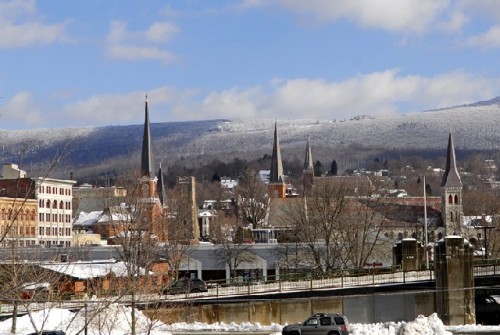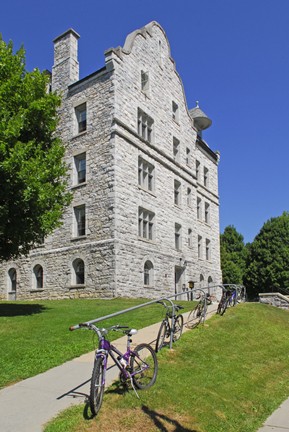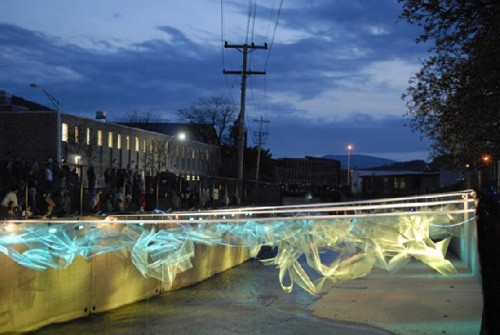A Portrait of the Northern Berkshires: North Adams, Adams and Williamstown
A Picture Book from Eric Rudd and Kelly Lee
By: Charles Giuliano - Nov 13, 2008
A Portrait of the Northern Berkshires: North Adams, Adams and Williamstown
Written by Eric Rudd with photography by Kelly Lee
Graphic Design by Keith Bona
Published by Cire Corporation, North Adams, Mass.
Printed by Bona Marketing and Printing, North Adams
50 pages, with more than 100 color illustrations, First edition: 5,000
$14.95 at 40 retail outlets and amazon.com or contact
http://www.ericrudd.com
http://www.cirecorp.com
The handsome, horizontal formatted, glossy picture book "A Portrait of the Northern Berkshires: North Adams, Adams and Williamstown" conceived with text by the artist/ entrepreneur, Eric Rudd, and the gorgeous, rich and color saturated images by Kelly Lee, is an unabashed promo and rave up for the under appreciated virtues of the Northern Berkshires.
It is common to extol the bucolic, quaint "Yankee Magazine" attractions of Southern Berkshire County. The illustrator, Norman Rockwell, celebrated American, small town life using the setting, as well as friends and neighbors, of Stockbridge, Mass. in his covers for the once ubiquitous Saturday Evening Post. The Red Lion Inn in the center of town is virtually a shrine and national monument. Stockbridge is now home to the Norman Rockwell Museum which is one of the top attractions of the region.
During the summer there is an influx of tourism, largely New Yorkers, who come to Southern Berkshire County for its world class programming at Tanglewood Music Festival, dance at Jacob's Pillow, the venerable Berkshire Theatre Festival, and the renowned Shakespeare & Company.
Until fairly recently Northern Berkshire County received only an increment of that buzz and tourism. It was the norm for vacationers to make, at best, a day trip to the Northern Berkshires to visit the Clark Art Institute, one of the finest small, regional museums in America with great depth in French Impressionist painting. During the summer months, visitors attend performances of the superb Williamstown Theatre Festival. Williams College is regarded as one of the top, upscale, small colleges in the nation and has an outstanding museum.
With the exception of the tenderloin of Williamstown, from Pittsfield, which is located Mid Berkshires, through the Northern Berkshires, the aura and ambiance was one of hard scrabble factory towns that had fallen on hard times. When the many, vast factories closed jobs went with them. There have been decades of economic depression in contrast with upscale Southern Berkshire County and its focus on arts, leisure and tourism.
Slowly, that has been changing. The turning point occurred when Tom Krens, then the director of the Williams College Museum of Art, launched a plan to transform the sprawling, abandoned campus of the former Sprague Electric Company, in the heart of North Adams, into the now thriving Massachusetts Museum of Contemporary Art. Already one of the two largest facilities for contemporary art in North America (the other is Dia Beacon in upstate New York) it has now greatly increased its exhibition space with a destination installation of more than 100 wall drawings by Sol LeWitt. It is the beginning of Mass MoCA building a permanent collection although the LeWitt murals are "loaned" for the next 25 years and are "owned" by private collectors and Yale University Art Museums.
While Mass MoCA was still in its planning stage, Eric Rudd and his wife Barbara, then resident in Washington, D. C., began to scout for a suitable factory, loft complex. They owned a substantial property in Washington which they sold and used the revenue to purchase the Beaver Mill in North Adams. There they created living quarters and enormous studio space. Initially, they launched the Contemporary Artists Center with its lively summer, artist residence program and gallery. That program phased out last year and Rudd hopes to relaunch a revived version. A portion of the Beaver Mill is occupied as artist studios.
Several years ago, Rudd developed the Eclipse Mill, in North Adams, as 40 large, loft studio spaces. These live/ work spaces average 2,500 square feet. Some units are larger and some smaller. Each unit was built out to the specifications of the buyer so they vary from simple and generic to quite elaborate. They were offered as "affordable" for artists and, based on the few units which have turned over, in general, have doubled in equity. Buyers must qualify as artists in order to purchase a unit.
With Mass MoCA thriving there is now a steady increase of travel and tourism to the Northern Berkshires. However, it has not proven to be the "magic wand" and economic engine that was pitched by Krens to then Governor Michael Dukakis. He signed the legislation for state funding as one of his last acts in office. The next governor, William Weld, initially stated that Mass MoCA would get funded "over my dead body." By then, Krens had departed for the Guggenheim Museum and the project was handed off to a Williams grad and Krens associate, Joe Thompson.
Slowly but surely Mass MoCA has created synergy with the Clark and Williams College to create a troika of cultural attractions. The Clark is in the process of developing a building on the Mass MoCA campus for mixed use including storage and exhibitions. The true impact on tough and funky North Adams, and nearby Adams, have yet to be fully realized. There is a lot of vacant commercial real estate and we have yet to see that increase of tourism spill over to Main Street. There continue to be town and gown issues. Long term residents and former Sprague employees dream of a return of manufacturing and jobs; which is unlikely. The growing artist community is slowly integrating with city. It will take time and trust as arts and tourism represents the true future for the formerly industrial region.
In this scheme of things, Rudd has been a visionary and entrepreneur. He gets things done but has proved to be controversial in the process. Perhaps, this is just the consequence of leadership and dramatic new ideas. In many ways this handsome book is as much as celebration of the rebirth of the Northern Berkshires as a document of his own impact and accomplishments. While a faltering economy makes it tougher Rudd is sanguine with ideas, projects and energy.
While the development of Mass MoCA dominates in North Adams it is also home to the small but ambitious and growing Massachusetts College of Liberal Arts. With the abundance of cultural resources in the region MCLA is moving strongly in the arts. It now has an undergraduate arts administration program. And, a couple of years ago, it founded Gallery 51 on Main Street. This past summer MCLA convinced a realtor to lease several vacant properties as temporary galleries. That helped to bring more traffic downtown. While the program has now ended it created a template for further thinking and development. In the currently tough economic climate several Main Street and Eagle Street businesses are closing as leases expire. The city has yet to initiate a cohesive and effective plan for its downtown.
This self published book is an example of entrepreneurship. Rudd conceives an idea and finds a way to execute it. This is his third book. The others were self help, reference books for artists "The Art World Dream: Alternative Strategies for Working Artists" and "The Art Studio/Loft Manual: For Ambitious Artists and Creators." These books were published in 2001 and may go into a Second Edition in 2009.
For this project Rudd recruited his lifelong friend, Kelly Lee, a former resident of D.C., and owner in the Eclipse Mill. Before moving to the Berkshires, for 30 years, Lee was a graphic artist for television news mostly with ABC News and The News Hour with Jim Lehrer. Much of the success and visual impact of this book derives from Lee's magnificent photography.
As a Berkshire resident Lee has been able to create these images through a range of seasons and perfect conditions. This produced unique results. The norm of a photographer for a book assignment would be to come in and do a shoot during a window of time hoping for good weather or perhaps setting up lights. Instead, Lee has taken the approach of "today is a perfect day to shootÂ…" He has also found interesting vantage points and panoramas. The result is a richly compelling portfolio of the region and its monuments.
Part of the strategy to raise money for the book was to sell space to loft owners and businesses as "Special Feature: Arts Spaces & Lofts." These vary from full to half pages with images of the loft space with the artist/ artisans at work and a brief text that they provided. There are 13 participants including double page spreads for Rudd and Lee.
Because of the "pay per view" arrangement the selection of artists and spaces is limited. There are important artists and dramatic spaces which are not included. The book would have benefited from a more objective editorial position. But this was a consequence of the need to raise funds for an expensive, self published book. The subscribed section of the book represent 12 of the overall 50 pages. The text for the book is also rather brief. One or two essays would have expanded the project beyond a picture book and photo essay. Of course this would entail additional pages and increased the cost of the publication.
Overall, this is a successful and attractive book. It is the perfect and affordable gift for friends and relatives. The appeal of the book is a souvenir for those who live in or have visited one of the great American destinations for travel and tourism. It is also a superb marketing tool for further development and entrepreneurship. We have a long way to go for the slowly recovering Northern Berkshire County but this publication effectively documents steps in the right direction.






